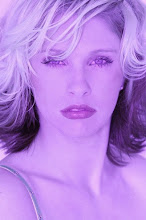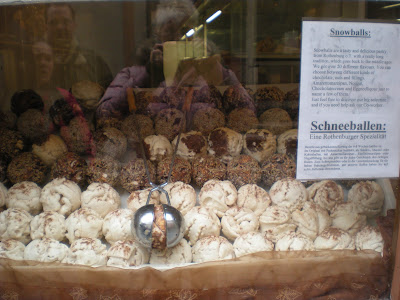Hey Blog!
Weather Report: The snow that fell yesterday didn't stick until we got up closer to Rothenberg (pronounced ROW-TEN-BURG), but we did have freezing rain this morning. Its deceivingly cold outside.
Everybody around here keeps talking about Fraconia (pronounced Frank-Cone-nia). So to better understand what exactly they meant I did some research. Here is what they mean when they say 'Franconia'
Franconia is a region of Germany comprising the northern parts of the modern state of Bavaria, a small part of southern Thuringia, and a region in northeastern Baden-Wurttemberg called Heilbronn-Franken. The Bavarian part is made up of the administrative regions of Lower Franconia Unterfranken, capital city Würzburg), Middle Franconia (Mittelfranken, capital city Ansbach), and Upper Franconia (Oberfranken, capital city Bayreuth).
Why this is especially important to me. My Mother was born in Wurzberg. Ansbach is where the larger base with the larger Commissary and PX are located. And as I mentioned before people keep talking about it.
Why 'Franconia?'
Franconia is named after the Franks, a Germanic who conquered most of Western Europe by the middle of the 8th century. Though one might assume that Franconia was the homeland of the Franks (indeed in German, Franken is used for both modern day Franconians and the historic Franks) this is not the case.
Modern Day Franconia:
Most of modern day Franconia became Bavarian in 1803 thanks to Bavaria's alliance with Napoleon. Culturally it is in many ways different from Bavaria proper ("Altbayern", Old Bavaria), however. The ancient name was resurrected in 1837 by Ludwig I of Bavaria. During the Nazi period, Bavaria was broken up into several different Gaue, including Franconia and Main Franconia
While Old Bavaria is overwhelmingly Roman Catholic, Franconia is a mixed area. Lower Franconia and the western half of Upper Franconia is predominantly Catholic, while most of Middle and the eastern half of Upper Franconia are predominantly Protestant. The city of Furth in Middle Franconia historically (before the Nazi era) had a large Jewish population; Henry Kissinger was born there.
East Franconian region is very different from the Austro-Bavarian language. Most Franconians do not call themselves Bavarians, but their insistence on this point is generally a lighthearted matter in modern times. In fact, Franconians will most likely take umbrage at insults directed at Bavaria.
Franconia has almost 300 mainly local, small breweries. The northwestern parts, the areas around river Main called Franconian wine region produce also a lot of wine. Food typical for the region includes Bratwurst (especially famous small Nuremberger Bratwurst), Schäuferla, Saurbraten, dumplings, fried carp, Obatzda, Head cheese. A traditional sort of biscuit are Lebkuchen or Küchla (sort of sweet fried dough).
Why people are talking about it:
Every time it is mentioned by a local they are really proud of it. I suspect it is very much how I happily and pridefully claim I am from Alaska! Also, the dialect of German that is spoken here is different then they way Germans in other regions speak German. This has become obvious since my High School German teacher taught us a dialect that is closer to Munich, I have been corrected or people have looked at me like I am not from around here. And last but not least, the diet, Heidi did tell me that Bratwurst and Saurkraut were a 'traditonal franconian dish.'
Okay......after 45 minutes of searching for a good map and a near divorce between LEGS and I, I have given up on putting a map!
Our first ride on the train!
This morning we got up early to take our very first travel trip in NEVER NEVER LAND to Rothenberg, also known as The Christmas City. Those of you who know me, know that I love Christmas so much I was married just 5 days before Christmas.
Rothenburg is a town in the district of Ansbach well known for its well-preserved medieval old town, a destination for tourists from around the world. In the Middle Ages, it was an Imperial Free City.
Our first ride on the train!
This morning we got up early to take our very first travel trip in NEVER NEVER LAND to Rothenberg, also known as The Christmas City. Those of you who know me, know that I love Christmas so much I was married just 5 days before Christmas.
Rothenburg is a town in the district of Ansbach well known for its well-preserved medieval old town, a destination for tourists from around the world. In the Middle Ages, it was an Imperial Free City.
The name "Rothenburg ob der Tauber" means, in German, "Red fortress above the Tauber". This is so because the town is located on a plateau overlooking the Tauber river. As to the name "Rothenburg", some say it comes from the German words Rot (Red) and Burg (burg, medieval fortified town), referring to the red colour of the roofs of the houses which overlook the river. The name may also refer to the process of retting ("rotten" in German) flax for linen production.
In March 1945 in WWII, German soldiers were stationed in Rothenburg to defend it. On March 31, bombs were dropped over Rothenburg by 16 planes, killing 39 people and destroying 306 houses, six public buildings, nine watchtowers, and over 2,000 feet (610 m) of the wall.
The U.S Assistant Secretary of War John J. McCloy knew about the historic importance and beauty of Rothenburg, so he ordered US Army General Jacob L. Devers not use artillery in taking Rothenburg. The local military commander Major Thömmes ignored the order of Adolf Hitler for all towns to fight to the end and gave up the town, thereby saving it from total destruction by artillery.
What makes Rothenburg ob der Tauber Germany even more exciting is its reputation as town of eternal Christmas. All year round lots of shops offer beautiful handcrafted Christmas gifts and keepsakes. In December the town gets really crowded, because nobody wants to miss the famous Christmas Market, one of the most romantic ones in Germany.
We went to the World Famous Käthe Wohlfahrt Christmas Village of Rothenburg ob der Tauber today. Inside there is countless handcrafted Christmas decorations and ornaments of wood and glass, twinkling lights and nutcrackers as well as many other souvenirs. But be careful, prices are accordingly high! I was only able to purchase one very simple ornament for Grams, Mema, The Mommy, Sister, Sissy, Rylee, and The Daddy and Lena, without breaking the Bank of LEGS.
We had a delicious German style lunch at one of the local restaurants.
LEGS said 'This is a man meal, 3 Phallus like meats over beans.....
The Mommy: Spaztel....very good gotta learn how to make it- need machine!!!
Homemade Maultaschen- Stuffed noodles DELICIOUS!!!
After lunch we went and had Schneeballs (pronounced SHNEE-Balls or known as 'Snowballs') this is something special Rothenberg does. They were also VERY yummy!
Random Thoughts:
Even though I am eating a lot of junk my a** still isn't getting too fat!
Please if you have facebook, check out the other pictures that were not included in this blog, we took 120 pictures and it took me hours to load this small handful.
Over & Out...
Just another day in life of an unlikely military wife.....**









































I'm glad you like the food there...I never thought of myself as a picky eater but I actually LOST weight when I visited! I totally forgot about the red fortress...I liked that place!
ReplyDeleteInteresting little tidbit...well for me anyway because of my profession...radiation was discovered in Würzburg by Whilhelm Röntgen (we spell it Roentgen in my field) in 1895.
Thanks for sharing Riah I did not know that... I will make sure to add that in the blog of Wurzberg
ReplyDeleteHello you may or may not remember me but i am Caleb Moore, im Maile and Shane Moores son. I found out about this blog through Linda when our family was over for dinner last night. SHe told me about you and your husband being stationed in Germany for 3 years. She thought i would be really interested in reading about Germany, honestly i love reading about Germany mostly the World War 2 era. When i see the pictures you take of the scenery and the buildings i feel like I go back in time to World War 2. Im so glad you made a blog about Germany. I too wish to travel to Germany and explore the many towns and cities learning about what happened in that place during the war. I look forward to reading more blogs about Germany.
ReplyDeleteHey Caleb, I remember you! How are you? I am glad that you like my blog, and I will try to write about as much history as I can while I am here- just for you! If you haven't yet you should read the Anne Frank Diary! Love on ya tiff**
ReplyDelete